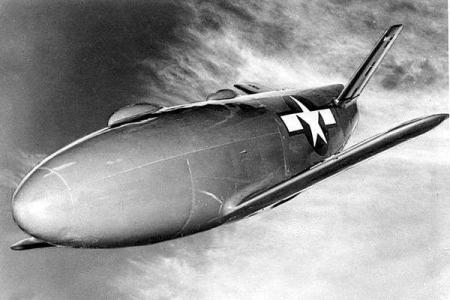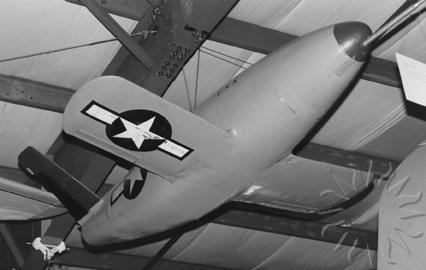McDonnell LBD/KSD/KUD/RTV-N-2 Gargoyle
As a response to the German efforts in the field of guided anti-ship glide bombs (Hs 293 and FX-1400), the U.S. Navy issued a requirement in October 1943 for a similar weapon, to be named Gargoyle. The Gargoyle was to be carried by carrier-based aircraft, and be equipped with an armour-piercing warhead in the 450 kg (1000 lb) class. In June 1944, the design had been finalized, and McDonnell was awarded a contract for the production of the first batch of LBD-1 Gargoyle glide bombs for test and evaluation purposes. Its anticipated low-cost and then unique armour-piercing capability saved the Gargoyle program in early Naval missile program reviews.
 |
| Photo: Boeing |
| RTV-N-2 |
Except for its V-tail, the LBD-1 was of very conventional layout. Although it was essentially a glide bomb, it had an Aerojet solid-propellant rocket booster to achieve a high diving speed. After release from the launching aircraft, Gargoyle was visually tracked using a bright flare in the missile's tail, and corrective commands could be sent via a radio command link.
 |
| Photo: Smithsonian Institution |
| RTV-N-2 |
Glide tests of the LBD-1 began in March 1945, followed by the first powered flights around July that year. In October 1945, the LBD-1 was redesignated as KSD-1 anti-shipping missile, but this was changed in early 1946 to KUD-1, when Gargoyle was downgraded to research vehicle status. The success rate of early Gargoyle flight tests was disappointing, and the first fully successful powered and guided flight of a KUD-1 did not occur before July 1946. When the production of the first 200 Gargoyles was completed in mid-1947, no follow-up orders were placed. The remaining missiles, again redesignated as RTV-2 in September 1947 and RTV-N-2 in early 1948, were subsequently used to test components for other guided missile programs. In December 1950, the RTV-N-2 program was officially terminated and surviving missiles were scrapped.
Specifications
Note: Data given by several sources show slight variations. Figures given below may therefore be inaccurate!
Data for KSD-1 (RTV-N-2):
| Length | 3.08 m (10 ft 1 in1) |
| Wingspan | 2.59 m (8 ft 6 in) |
| Weight | 680 kg (1500 lb) |
| Speed | 965 km/h (600 mph) |
| Range | 8 km (5 miles) |
| Propulsion | Aerojet 8AS1000 solid-fueled rocket; 4.4 kN (1000 lb) for 8 s |
| Warhead | 450 kg (1000 lb) armour-piercing |
Main Sources
[1] Norman Friedman: "US Naval Weapons", Conway Maritime Press, 1983
[2] Frederick I. Ordway III, Ronald C. Wakeford: "International Missile and Spacecraft Guide", McGraw-Hill, 1960
[3] Bill Gunston: "The Illustrated Encyclopedia of Rockets and Missiles", Salamander Books Ltd, 1979
[4] US Navy: "Model Designations of Naval Aircraft", 1947 and 1950
Back to Directory of U.S. Military Rockets and Missiles, Appendix 1
Last Updated: 4 February 2003